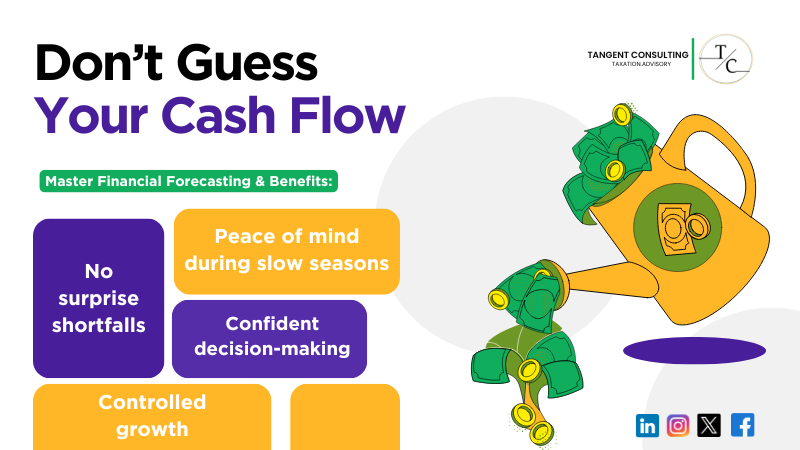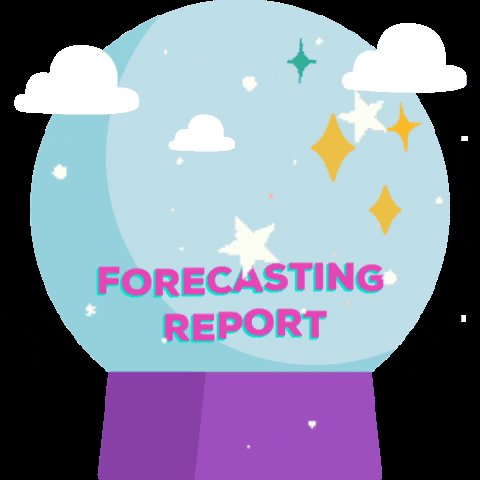Don’t Guess Your Cash Flow: Financial Forecasting for Startups 101

Last week, we got a notification that $55 was debited from our Figma Pro subscription account. We stopped for a moment and realized we hadn’t been using Figma for two months.
Businesses lose money this way; however, even the smallest expense matters for a startup. To counter such situations, there is financial forecasting for startups, and that’s what we are going to discuss today.
We’re going to break down the basics of financial forecasting for startups, what it is, why it matters, and how to build projections. So, make sure to stick with us.

What Is Financial Forecasting for Startups?
Financial forecasting is your best guess (backed by numbers) about how much your startup will make and spend. This assists the startups in several ways. It helps identify future costs and revenue trends that can influence business goals in the short/long term.
Most startups start with a simple forecast that covers the first 18 months. But if you’re looking to attract investors, they’ll probably want to see a detailed outlook for at least three years. That includes expected revenue, costs, and whether you’ll be making a profit/loss.
Your forecast should include monthly sales projections, estimated expenses, and a basic profit-and-loss overview.
Let’s say Batcave Construction just launched. They expect to bring in $50K a month from small residential jobs for the first six months. But they also know they’ll spend around $30K monthly on materials, wages, and equipment rentals.
That leaves them with an estimated monthly profit of $20K. By forecasting this over the next 18 months, they can plan when to hire more crew, upgrade gear, or pitch for bigger contracts.
Don’t Let Business Numbers Hold You Back 🚀
Most business owners know they should get a grip on their finances — but don’t know where to start. That’s where we come in. Book a free 1-on-1 call with Tangent Consulting and let’s untangle your numbers together.
Why Financial Forecasting Matters for Startups?
Starting a business is exciting, but it’s also risky. According to the U.S. Small Business Administration, there are nearly 34 million small businesses across the country. But here’s the tough part: about 1 in 5 don’t make it past their first year, and only half survive beyond five years.
Why do so many fail? The usual suspects are:
- Launching without a clear demand
- Cash flow issues
- Struggling to manage costs or set the right prices
- No solid financial plan or business model
This is where financial forecasting makes a real difference. It helps you identify problems early so you can avoid them.
If you’re trying to raise money, your forecast becomes even more important. Investors will want to know when you expect to break even. They also want to see how you’ll manage your cash flow during the early, often unprofitable days. Besides, lenders use your forecast to determine whether you’re a good credit risk.
One thing to keep in mind is that financial forecasting isn’t the same as accounting. Accounting shows what has happened, while forecasting is all about what might happen.
But the two go together. A good forecast often relies on accounting data from your records or similar businesses to build a realistic plan.

Financial Forecasting for Startups: Key Elements
If you’re looking to build solid revenue projections and grow your business confidently, here are five key pieces every startup needs in its financial forecast.
1. Total Addressable Market (TAM)
TAM stands for Total Addressable Market and shows how much you could make if you captured 100% of your target market.
While no startup gets the whole pie, knowing your TAM helps you understand your industry’s full potential.
It also helps you figure out where you stand, how big you can grow, and what goals are worth chasing. With a clear TAM, it’s easier to build a plan that scales and keeps your startup moving in the right direction.
2. Pipeline Forecast
Think of your pipeline forecast as a peek into your future revenue. It’s based on your current sales opportunities and how likely you can close each.
By looking at what’s in your sales pipeline, such as deals in progress, hot leads, and maybe even those long shots, you can set realistic revenue targets, adjust your strategy, and decide where to focus your energy.
3. Expense Forecast
Every startup has bills to pay, and an expense forecast helps you keep track of them all. This includes fixed costs like rent, salaries, insurance, and variable costs like materials, marketing, or commissions. Don’t forget day-to-day operating expenses like software, utilities, and office supplies.
When you update your expense forecast, you can spot where to cut back, plan smart investments, and avoid burning cash.
4. Cash Flow Projection
Cash flow is about knowing when money comes in and when it goes out. A cash flow projection shows if you’ll have enough to cover your bills or if a shortage is around the corner.
It’s crucial for planning how much runway you have, managing payments, and even negotiating with suppliers. Running low on cash is one of the top reasons startups fail, so keeping tabs on your cash flow is non-negotiable.
5. Profit and Loss (P&L) Projection
The P&L forecast (also called an income statement) gives you the big picture. It shows your projected revenue, costs, and profit or loss.
This summary helps you see if your business model makes sense and where to tighten things. Are you overspending on production? Are there ways to boost revenue? The P&L gives you the insight to fine-tune your plan and improve profitability.

Tips on How to Form Financial Forecasts
Creating a financial forecast might seem simple at first, but to truly make your forecast useful and accurate, there are a few key strategies to keep in mind that can help maximize your capital return.
1. Update Your Forecasts Regularly
Your initial forecast might predict hitting $500,000 in monthly recurring revenue within 3 months, but what if leads to a decline? In situations like this, it’s crucial to update your forecast based on new data, such as a drop in leads.
The last thing you want is to make decisions based on outdated numbers. Regularly revisiting your forecast ensures you stay aligned with reality and adjust quickly to changing circumstances.
2. Create Multiple Projections for Your Startup
Relying on a single financial plan is risky. Business can turn out better or worse than expected, so having several projections ready is important. By doing this, you can better navigate different outcomes and have a plan for various scenarios. Having alternative projections helps you stay prepared no matter what the market throws your way.
3. Focus on the Most Impactful Variables
When creating forecasts, there are many factors that could affect your numbers, like sales force performance, conversion rates, market conditions, and even macroeconomic trends.
The good news is, you don’t have to track every single variable or obsess over creating perfect projections. Focus on the key factors that have the biggest impact on your business and let those drive your forecast.
If you’re ready to get started, check out our free startup forecasting template, used by 7-figure clients to help them streamline their financial projections and make more informed decisions. It’s a practical tool designed to guide you through the forecasting process, saving you time and ensuring you stay on track.
Download Our Startup Financial Forecasting Template
Used by 7-figure clients to plan for growth, raise smarter, and stop guessing cash flow. Get the exact spreadsheet to help startups scale confidently.
Get the Free TemplateFinal Thoughts
So, there you have it! With these tips in mind, you’ll be able to create forecasts that better reflect your business’s true potential and help guide you through both the good times and the challenges.
When doing financial forecasting for startups, it’s important to update it regularly, ideally every six months or whenever there’s a major shift in your business.
This is because a forecast is only as good as the assumptions it’s built on, which change over time.
If financial forecasting seems statistical gibberish, you don’t have to do it alone. Tangent Consulting helps small business owners like you outsource the entire accounting department. We help business owners like you build and maintain smart, flexible financial forecasts so you can focus on growth.
Let’s get your accounting system working for you!
P.S. If you are reading this, it means you can have access to our free consultation for your business. Avail this for free today before we change our mind.
FAQs
What is the best forecasting method?
It depends on your business, but most startups use a combination of historical data and scenario-based forecasting.
How to do financial forecasting in Excel?
You can start by listing income and expenses month by month, then use simple formulas to project cash flow, profit, and loss.
What is the difference between budgeting and forecasting?
Budgeting sets a fixed financial plan, while forecasting is an ongoing estimate that adjusts based on data and trends.
